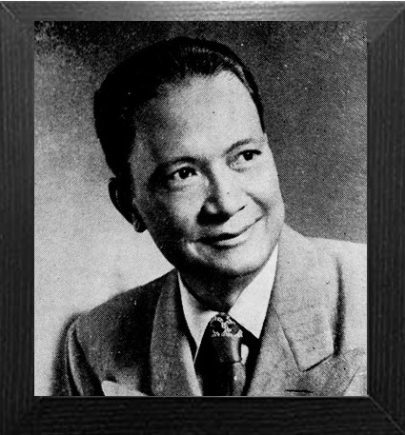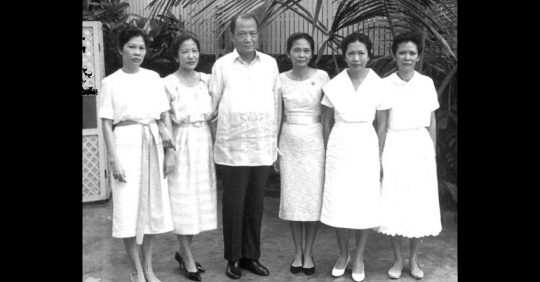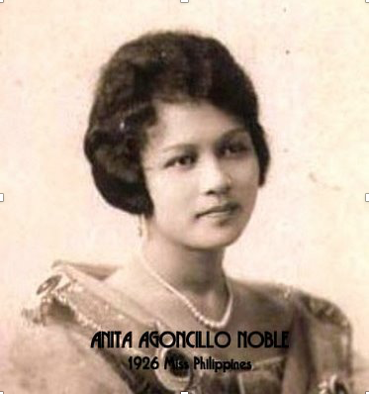Tahanan ng mga Katipunero
Home of Heroes of the 1896 Revolution
Ang Mga Maybahay
They Lived Here

Juan Felipe Nakpil
(May 26, 1899 – May 7, 1986)
Artist & Filipino
A Legacy of Architecture
In March 2006, there was a flurry of protest, mainly by conservationists, journalists and bloggers, upon the impending demolition of the Avenue Theatre to make way for a parking lot. The building’s end happened quickly, leaving them to mourn another loss of heritage, the work of a National Artist, Juan F. Nakpil.
The Avenue theatre was described as “a grand Art Deco structure that provided entertainment to generations of Manilans… a landmark building that helped define Manila’s downtown – Avenida Rizal… Nakpil had designed it as a cutting-edge cinema before the war and he renovated it after the war to cater to new technologies of air-conditioning, Technicolor, and wide screens.” (Villalon, PDI)
Many of the agitated bloggers were not old enough to have watched movies at the Avenue, but knew the value of the few surviving pre-war structures to our cityscape and culture. Other online writers were more familiar with another lost Nakpil structure, the Rizal Theater in Makati which was the iconic setting for memories of the 1960’s to 1980’s. This outstanding structure featured not only movies but live performances seeking Nakpil’s care for acoustics in design.
And how would generations recall the University of the Philippines, without seeing the sweep of the Administration Building behind the Oblation statue, or the Carillon Tower of silent bells? Fortunately these and many of Nakpil’s buildings still stand while others remain in the mind’s eye, part of remembered history of place.
Revolution and Art in the Family
Juan Felipe Nakpil was born on May 26, 1899, the eldest child of Julio Nakpil and Gregoria De Jesus. Julio Nakpil was a musician and composer who fought in the Philippine Revolution against Spain and had been designated by Andres Bonifacio as secretary of the command in the north of Manila. He later married Bonifacio’s widow, Gregoria, who was also a courageous leader of the Katipunan.
left to right: Josefina Nakpil Tapales, Julia Nakpil Casas, Juan Nakpil, Francisca Nakpil de Lange, Mercedes Nakpil Zialcita, Caridad Nakpil Santos-Viola

While he also trained to play the piano, Juan’s inclination to the visual arts must have been boosted when as a child in 1907, he won the silver medal in a Rizal Day drawing competition. He further trained in freehand drawing with Fabian de la Rosa and Fernando Amorsolo, then already distinguished artists, and would have been inspired by his aunt Petrona Nakpil-Bautista, who excelled in painting. The Nakpil family was also known for the Plateria Nakpil, where fine jewelry was designed and crafted.
Beyond Borders in Architecture
When Juan Nakpil was on the second year of his course in civil engineering at the University of the Philippines, he took the bold decision to go the United States for his studies despite the disapproval of his family. He left what must have been a favored life as an only son with five sisters, by pawning his watch to buy a steerage ticket to America.
Nakpil studied civil engineering at the University of Kansas, supporting himself by working as a pianist with the Filipino Strong Orchestra, and later as a partial scholar of the Philippine government and with assistance from his uncle, the nationalist and philanthropist, Dr. Ariston Bautista-Lin. There he obtained his degree in civil engineering in 1922. However, he was not content, and with his uncle’s encouragement, he decided to pursue his true passion, travelling to France to study architecture at the Fountainebleau School of Fine Arts. Nakpil studied with the noted architects Carlu and Lalouz and was listed among the top ten in his class of forty, easily gaining the Diplome d’ Architecture. He returned to the United States with a Joseph Evelyth fellowship to Harvard University where he got his master’s degree in architecture in 1926.
Outstanding Early Career
Upon his return to Manila in December 1926, Nakpil began working as assistant architect at the Bureau of Public Works. He then joined the firm of the reknowned architect Andres Luna de San Pedro two years later as junior partner. Among the projects resulting from Nakpil’s collaboration with Luna were the Perez-Samanillo building, St. Paul’s Chapel, the Crystal Arcade and residences like those of Rafael Fernandez and of Jacobo and Alfonso Zobel.
Nakpil began to apply some of his observations on modern lighting and architectural treatment at the Paris Exposition des Arts Decoratifs et Industriel Modernes of 1925, such as in the remodelling of the old Ideal Theatre. The exposition which gave the Arts Deco movement its name, also influenced him as he introduced the latest concepts in furniture design as the designer for Gonzalo Puyat and Sons from 1928 to 1931. Also wonderful models of this style adapted to the Philippine setting are the Manila Jockey Club Building and the residences Nakpil designed for Javellana, Lacson, Legarda, and Vicente Lim, gracing the Vito Cruz area in Pasay City. By this time, he had already established his own architectural firm in 1930.
At the same time that Nakpil embarked on his first architectural projects, he also began teaching. He joined the Mapua Institute of Technology from 1927 to 1931, teaching history of architecture, theory of architecture and design for the junior and senior years. Then in 1931 to 1938 he taught at the University of Sto. Tomas College of Architecture. Thus he helped educate a generation of architects, such that during a certain period, all six deans of architecture of different schools had been his students.
In 1941, Nakpil founded the Philippine College of Design with many of the leading architects like Andres Luna de San Pedro, Juan Arellano, Pablo Antonio and others, until World War II interrupted this project. Earlier, in 1933, he had also established with other top architects the Philippine Architects Society (later renamed Philippine Institute of Architects) and served as its first president.
The Architect as Citizen
Juan F. Nakpil also held various positions of trust with the government, as he generously contributed his skills. Among the positions he held were Chairman of the Board of Examiners for Architects, member of the Building Code Committee of Manila, member of the Zoning and Building Committee of Manila, Consulting Architect of the Republic assigned to the University of the Philippines and member of the Philippine Historical Commission.
He was also Consultant to the Headquarters, Philippine Army for 1936 to 1958, and responsible for the design of its building, uniforms, medals and insignias. For his services during the war as engineer and planner, he was promoted to Colonel and awarded various medals and commendations by both the Philippine Army and United States Army.
Nakpil was also an active leader of various civic organizations like the Rotary, Boy Scouts of the Philippines, Knights of Rizal and Philippine Tuberculosis Society, where he often donated his services. In 1947, he was made a papal knight of the Order of St Sylvester for distinguished services rendered to the church. He was architect of the 33rd International Eucharistic Altar, and much later the 2nd National Eucharistic Congress altar, as well as the Quezon Institute Chapel and the Santiago Hospital Chapel and various restoration projects.
A Concern for History and Heritage
An early project of Juan F. Nakpil was the renovation and enlargement of the Quiapo Church after it had been razed by fire in 1929. His work on the restoration of the home of Dr. Jose Rizal in Calamba started with researches in 1932, until its completion and inauguration in 1950. He also did the restoration of Rizal’s cell in Fort Santiago.
Another restoration project that Nakpil worked on much later in the late 1970’s was the Sta. Ana Church in Manila. He earned the grateful prayers of the parish leaders, as he supervised pro-bono the careful tasks of bringing back the old church to its former glory of round-domed towers and stained-glass windows.
Nakpil also designed the Mabini Shrine in Tanauan, Batangas. Ironically, some of his designs were considered “too modern”, such as his early design for the Bonifacio Monument, which won 2nd place in the competition. Much more controversial was his stainless steel shaft/pylon superimposed over the granite obelisk of Dr. Jose Rizal’s monument in Luneta in celebration of Rizal’s centenary in 1961. Although the design was actually fitting as part of a modern national theatre and arts complex designed by Nakpil for the area, it was eventually removed two years later, still unappreciated by the public.
A Modern Sensibility
Other innovations of Nakpil were successfully integrated – the magazine celebrating his silver jubilee as an architect in 1953 cited some projects:
Uy Yet Building
One of the earlier works of Nakpil, was the first building to feature concrete media agua.
Manila Jockey Club Building
–made use of exposed staircase as an architectural motif of the building, which as cantilevered stairs, concrete media aguas and balconies.
Residence of General and Mrs. Vicente Lim
– made us of wood in the wide eaves projecting two meters from the face that were adapted in the design of this modern house. Climatic conditions in the country were taken into account.
In the 1950’s Nakpil made striking use of the newly developed thin-shell concrete construction in works like the Rizal theatre and the Social Security System (SSS) Building. Aside from the folded plate facade and roofline, the SSS building remains a modern classic with the staircase fully visible through the glass windows.
Heralding Philippine Architecture
Juan Nakpil spoke of a Philippine architecture, that was attuned to the climatic and seismological conditions, and the environment of the nation. Villalon notes:
“After World War II, Nakpil developed a structural system based on the Philippine”house on stilts” that he first used for proposed government center buildings at Diliman that unfortunately not constructed. However, the idea evolved into a design principle in the buildings he designed for the new University of the Philippines campus in Diliman, where the stilts were adapted into a structural component that allowed simple, open and effective floor planning leading to the easy partitioning of the interiors.”
A Full Life
In the midst of his stellar career, Juan F. Nakpil had raised a family with his wife Anita Agoncillo Noble of Batangas, who had been crowned the first Miss Philippines in 1926. Their three sons, Ariston, Francisco, and Eulogio excelled as architects and engineer, and joined him in the firm Juan F. Nakpil and Sons, which was established in 1953. Their daughters Annie (Mrs. Renato Tanada) and Edith (Mrs. Francisco Rabat) also thrived in their chosen vocations.
In 1973, the Nakpil family joyfully celebrated Juan F. Nakpil’s most
significant award, as the first National Artist of the Philippines for
Architecture. They were joined by the many friends of the very sociable
and civic-minded gentleman.
Juan F. Nakpil passed away peacefully at the age of 86. His consummate artistry was rewarded in the many outstanding structures that survive him.

Gregoria de Jesus had written a kartilla of her own in 1928: ten guidelines especially for the youth. Number four was : “Pagsikapang magkaroon ng anumang karunungan na tumutugon sa kanyang hilig upang pakinabangan ng bayan.” (Strive to develop expertise whatever your vocation , to be of service to the country.)
Juan F. Nakpil had indeed taken to heart these and his mother’s other guidelines for a life of honor and heroism.
By Arch. Francisco Nakpil and Karen Nakpil Tañada in commemoration of the 111th anniversary of Arch. Juan Nakpil’s birth.
